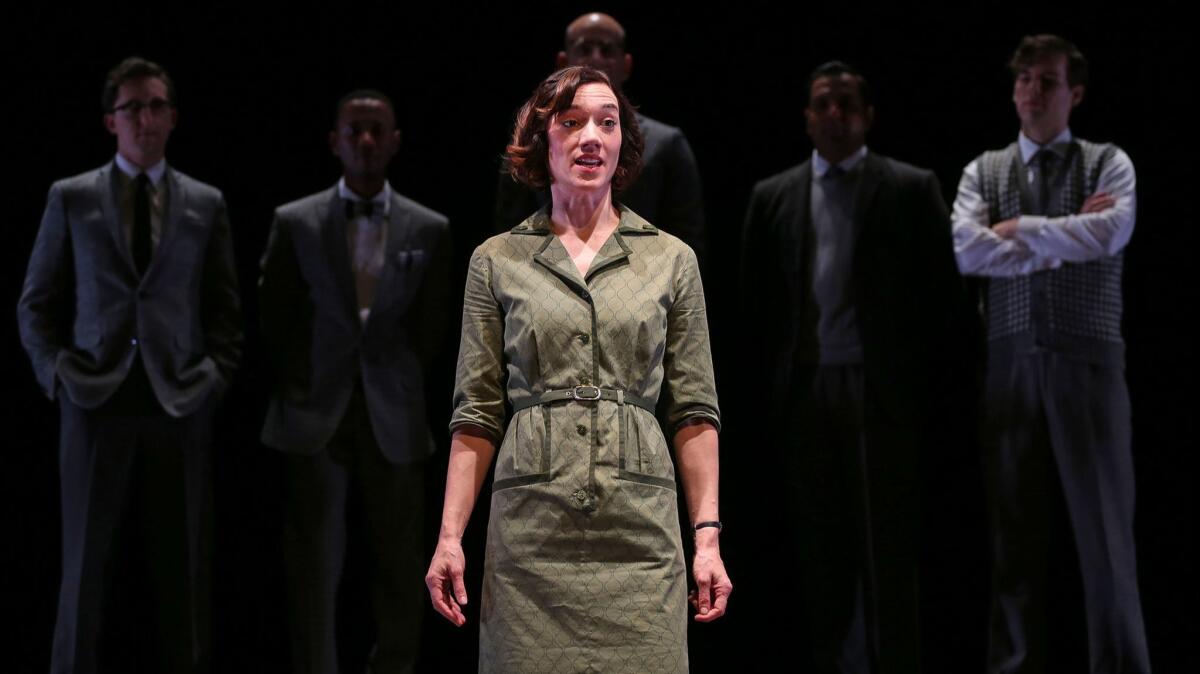Review: She helped discover DNA. History may have forgotten her, but ‘Photograph 51’ does not

Every once in a while we experience a flare-up of puzzlement about why so few women pursue careers in math and science — even now, despite progress in gender equality.
Well, maybe the STEM fields need a new publicist. Stories about women in science tend to downplay the glamour while stressing the potential obstacles: sexism, the misattribution of work to male colleagues and, in the play “Photograph 51,” radiation poisoning, early death and historical oblivion.
South Coast Repertory’s revival of Anna Ziegler’s play will not boost science’s reputation among women. Its protagonist, Rosalind Franklin, is based on a real chemist and X-ray crystallographer who worked at King’s College in England in the 1950s.
AT THE WALLIS: The low-tech magic of ‘The Old Man and the Old Moon’ »
Franklin’s Photograph 51, an X-ray diffraction image of a DNA molecule, led to the discovery of the double helix, the elegant, endlessly self-replicating structure that drives all life on Earth. James Watson, Francis Crick and Maurice Wilkins shared the Nobel Prize for it in 1962. Franklin didn’t. She had already died at age 37 of ovarian cancer, incurred or at least hastened, the play suggests, by all those X-rays.
“Photograph 51” may not tempt a new wave of women into genetic research, but that’s not to say that this stylish and informative production, directed by Kimberly Senior, is a downer. Schadenfreude is hard to resist, and if we can’t go back in time and give Franklin the recognition she deserved, we can at least enjoy watching her stage proxy make the men of 1950s biophysics — including Watson, Crick and Wilkins — look like bumbling stooges.
SOCAL THEATER: This week’s picks from the small-stage scene »
As played by the commanding Helen Sadler, Franklin is the Mary Poppins of the lab, a humorless Englishwoman with an impeccable accent whose stringent professionalism infantilizes otherwise high-functioning adults. Franklin is not susceptible to flattery, flirtation, gifts, cow eyes, friendly banter, literary references, jocosity, open mockery or any of the other strategies the silly men use to soften her up. She doesn’t suffer fools gladly or in fact at all, and she usually has the last word.
Her poor colleague Wilkins (George Ketsios) fumbles in the first scene— he’s patronizing and awkward — and never recovers. Although they’re supposed to be partners, Franklin insists on working alone. “You don’t command my respect,” she informs him brusquely when he tries to look at her data. Their tart exchanges are comically moderated by their long-suffering PhD student, Ray Gosling (Riley Neldam), who flutters between them like a child of divorce.
Of course the audience knows that this antipathy can mean only one thing: sweet, sweet romance! Whereas in real life Franklin and Wilkins gave no evidence of privately nursing softer feelings for each other, the play — a bit reluctantly, as if against its own better judgment — succumbs to the pull of these narrative expectations. The more Franklin abuses him, the more lovesick Wilkins grows.
When Franklin strikes up an uncharacteristically warm collaboration with an American scientist, Don Caspar (Josh Odsess-Rubin), Wilkins is left gazing forlornly at them across the stage. It’s no wonder Watson and Crick get the jump on him in building the first DNA model.
Saucily, Ziegler relegates these two historical lions to her B-plot, portraying Watson (Giovanni Adams) as a brash, clownish opportunist and Crick (Anil Margsahayam) as a bit smoother but just as ruthless. Lest we persist in rooting for them anyway, whenever they’re not exploiting other scientists’ work, they’re trading misogynist banter. Contrasted with their headlong approach, Franklin’s caution — she won’t say that DNA is a helix, only that it “appears helical” — proves her tragic flaw.
PLAYWRIGHT: Meet the woman behind ‘Black Super Hero Magic Mama’ »
Ziegler’s framing device — the characters are aware that they are performing a play, and they take turns providing narration — keeps viewers focused on the will-they-or-won’t-they suspense, not letting scientific jargon bog things down.
Director Senior keeps the pace taut, and she does her best to offset the script’s talkiness with stage business. There are maybe too many scenes in which Franklin and Watson stand at invisible lab stations miming “sciency” activities like turning cranks, sliding items into slots, squinting into microscopes. The cast also marches over Cameron Anderson’s raked, multilevel set with such vigor that a sprained ankle seems inevitable.
Ultimately, the love story — our carrot in a forest of sticks — is unpersuasive. It’s easy to admire Franklin’s unsentimental commitment to her work and her refusal to cater to bigots’ expectations, but we don’t learn much else about her. The play hints at unspoken depths beneath her surface, but her heart remains as mysterious as the DNA molecule before she took its picture.
♦ ♦ ♦ ♦ ♦ ♦ ♦ ♦ ♦ ♦
‘Photograph 51’
Where: South Coast Repertory, 655 Town Center Drive, Costa Mesa
When: 7:45 p.m. Tuesdays-Fridays, 2 and 7:45 p.m. Saturdays-Sundays; ends March 24
Tickets: $23 and up
Info: (714) 708-5555 or scr.org
Running time: 1 hour, 35 minutes
Support our coverage of local artists and the local arts scene by becoming a digital subscriber.
See all of our latest arts news and reviews at latimes.com/arts.
More to Read
The biggest entertainment stories
Get our big stories about Hollywood, film, television, music, arts, culture and more right in your inbox as soon as they publish.
You may occasionally receive promotional content from the Los Angeles Times.






